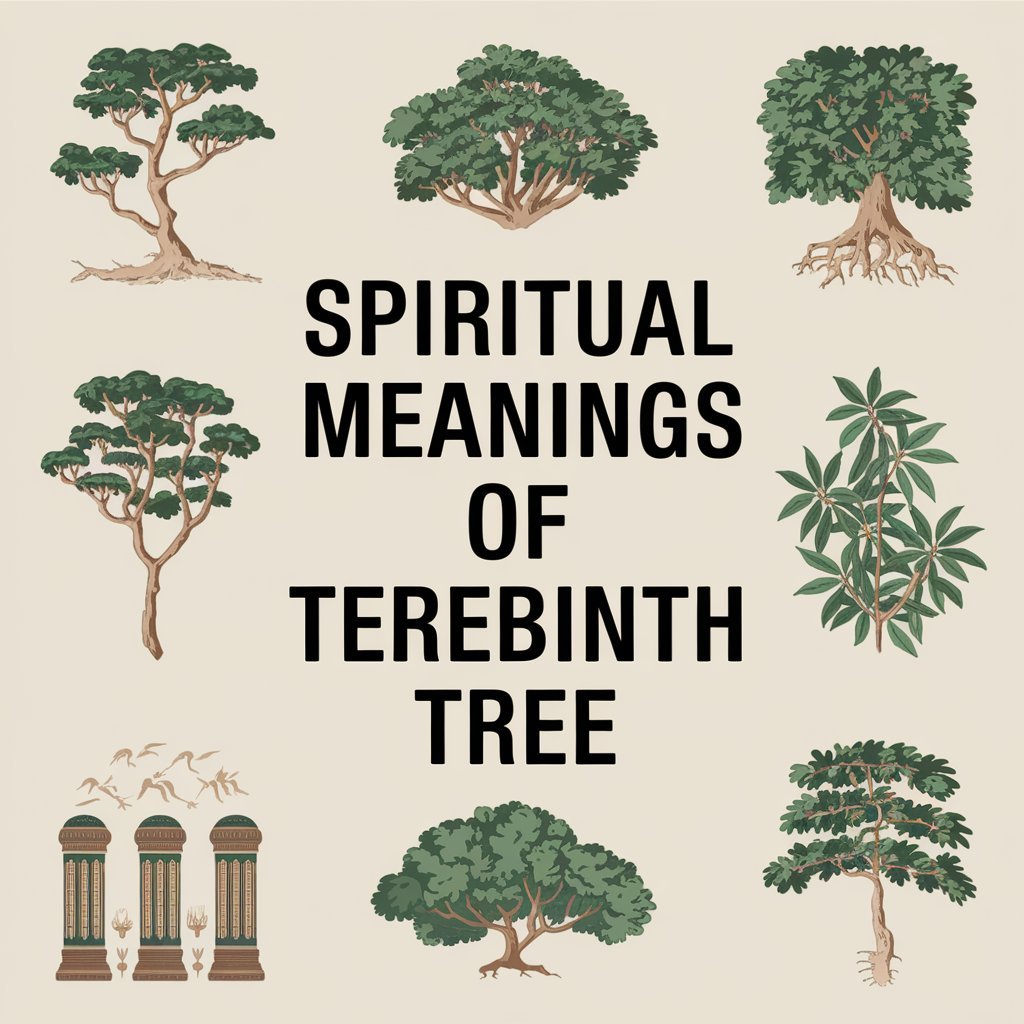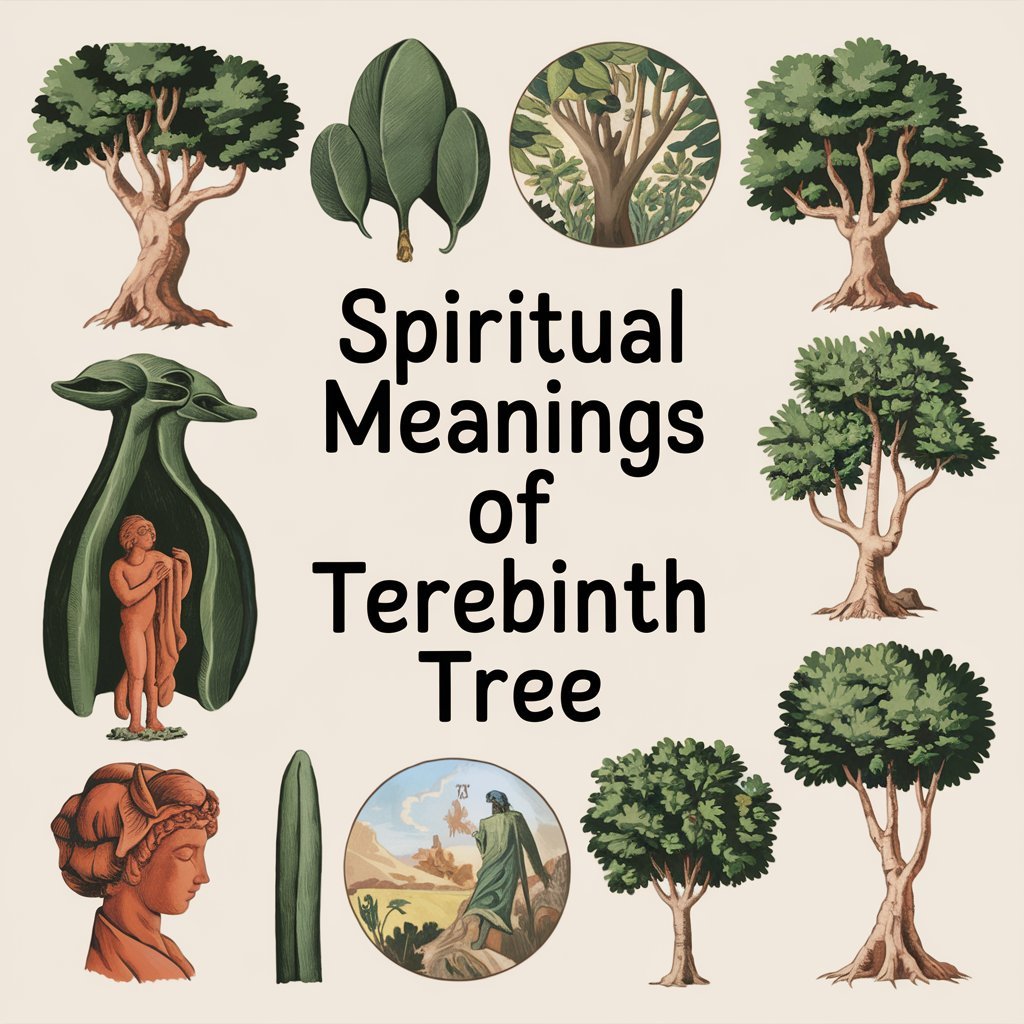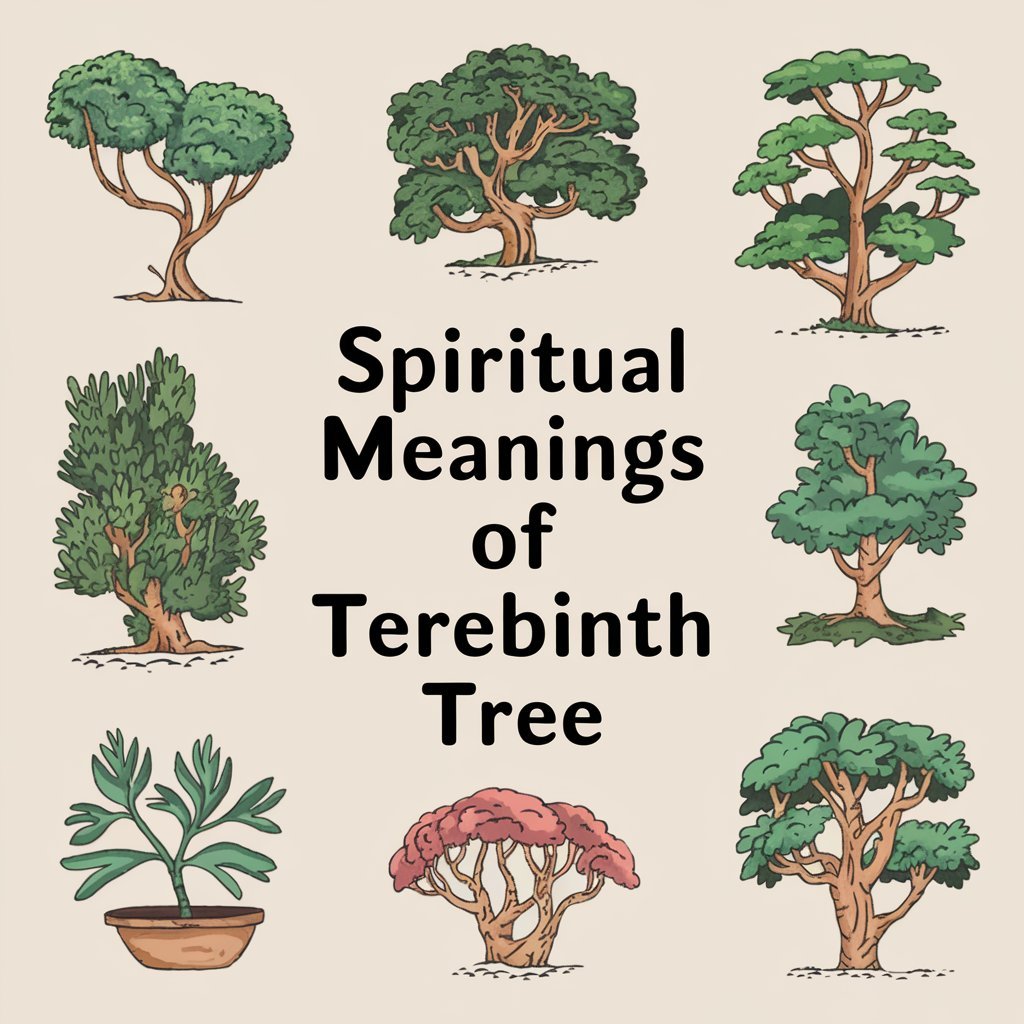12 Spiritual Meanings of Terebinth Tree: Hidden Meanings
As you explore the pages of the Bible, you’ll notice the terebinth tree emerging as a recurring symbol, woven into the fabric of pivotal moments and encounters. You might wonder, what’s the significance of this tree that seems to be more than just a backdrop for biblical events?
Its presence whispers secrets of strength, wisdom, and divine guidance, hinting at a deeper understanding of God’s nature and humanity’s relationship with Him. But that’s just the beginning – there’s more to uncover about this ancient symbol, and the stories it tells about faith, worship, and the sacred.
Key Takeaways
- The terebinth tree symbolizes spiritual receptivity, highlighting the importance of receiving and reciprocating divine guidance in the Bible.
- It represents strength and wisdom, attributes embodied by leaders and visionaries like Abraham, Joshua, and Deborah in biblical narratives.
- The tree’s presence often marks divine appointments and guidance, as seen in Abraham’s encounter with angels beneath the oaks of Mamre.
- The terebinth serves as a symbol of God’s presence and guidance, providing a sacred space for holy convocations and worship.
Abraham’s Encounter With Angels

The Terebinth tree is also famously associated with Abraham’s encounter with angels in the biblical account of Genesis 18. This encounter is a pivotal moment in the biblical narrative, and the Terebinth tree plays a significant role in the story. Here are some key aspects of Abraham’s encounter with angels under the Terebinth tree:
- Hospitality and Generosity: Abraham’s encounter with the angels begins with an act of hospitality and generosity. He welcomes the strangers and offers them food and shelter, demonstrating the importance of treating others with kindness and respect.
- Divine Revelation: The angels reveal to Abraham that they have come to destroy the cities of Sodom and Gomorrah, and that Abraham’s nephew Lot and his family are in danger. This revelation highlights the importance of listening to divine guidance and trusting in God’s plan.
- Intercession and Prayer: Abraham intercedes on behalf of Sodom and Gomorrah, asking God to spare the cities if there are any righteous people living there. This act of intercession demonstrates the power of prayer and the importance of standing up for what is right.
- The Terebinth Tree as a Witness: The Terebinth tree serves as a witness to Abraham’s encounter with the angels. It is a symbol of the divine presence and a reminder of the importance of honoring God’s messengers.
- A Turning Point in the Narrative: Abraham’s encounter with the angels under the Terebinth tree marks a turning point in the biblical narrative. It sets the stage for the destruction of Sodom and Gomorrah, and it highlights Abraham’s role as a leader and a prophet.
The Terebinth tree’s association with Abraham’s encounter with angels underscores its significance as a symbol of spiritual growth, protection, and guidance. It reminds us of the importance of hospitality, generosity, and intercession, and it highlights the power of prayer and the divine presence in our lives.
Symbolism in the Old Testament
The Terebinth tree is a symbol-rich element in the Old Testament, appearing in various contexts to convey spiritual and theological themes. Here are some examples of symbolism associated with the Terebinth tree in the Old Testament:
- Divine Presence: The Terebinth tree is often associated with the divine presence, as seen in Genesis 18:1-15, where Abraham encounters the Lord under the Terebinth tree of Mamre. This association emphasizes the tree’s role as a symbol of God’s presence and power.
- Covenant and Promise: The Terebinth tree is also linked to covenant and promise, as seen in Genesis 35:4, where Jacob buries the foreign gods under the Terebinth tree at Shechem. This act symbolizes Jacob’s commitment to the covenant with God and his rejection of idolatry.
- Protection and Guidance: The Terebinth tree is often depicted as a symbol of protection and guidance, as seen in Judges 6:11, where the angel of the Lord appears to Gideon under the Terebinth tree. This association highlights the tree’s role as a source of comfort and direction.
- Wisdom and Knowledge: The Terebinth tree is also associated with wisdom and knowledge, as seen in 1 Samuel 22:6, where Saul sits under the Terebinth tree on the hill of Gibeah. This association emphasizes the tree’s role as a symbol of wisdom and discernment.
- Idolatry and Paganism: In some contexts, the Terebinth tree is associated with idolatry and paganism, as seen in Hosea 4:13, where the Israelites are accused of sacrificing under the Terebinth tree. This association highlights the tree’s role as a symbol of spiritual corruption and rebellion.
Strength and Wisdom Embodied
The terebinth tree’s robust presence in biblical narratives often symbolizes strength and wisdom, attributes embodied by leaders and visionaries who sought to guide their people toward a deeper understanding of God’s will.
These Spiritual Pillars stood firm, rooted in Sacred Roots, unwavering in their commitment to God’s purpose.
As you explore into the scriptures, you’ll notice how the terebinth tree’s strength and wisdom are reflected in the lives of biblical figures like Abraham, Joshua, and Deborah.
They embodied the tree’s resilience, standing tall against the forces of adversity, and its wisdom, making wise decisions that shaped the course of history.
The terebinth tree’s symbolism reminds you that true strength and wisdom come from being rooted in God’s will, empowering you to stand firm and lead others towards freedom and spiritual growth.
Divine Appointments Under Terebinth
Under the terebinth‘s sprawling canopy, several biblical figures received divine appointments that altered the trajectory of their lives and the fate of their people.
You, too, can experience the divine shade of this sacred tree, where the burdened find solace and the seeking discover purpose.
Abraham, for instance, encountered God beneath the oaks of Mamre, a terebinth variant, receiving a promise that would shape the course of human history.
Similarly, Deborah, a prophet and judge, held court beneath the Palm of Deborah, a terebinth tree, dispensing wisdom and justice to the people of Israel.
In these moments, the terebinth served as a holy refuge, a symbol of God’s presence and guidance.
As you seek divine direction, consider the terebinth’s significance, and may its ancient wisdom inspire your own path forward.
Sacred Gatherings and Worship
As the terebinth’s majestic branches stretched towards the heavens, they sheltered sacred gatherings and worship, where ancient Israelites congregated to offer sacrifices, seek guidance, and celebrate momentous occasions.
You can almost imagine the rustling of leaves as they gathered beneath its canopy, their voices lifted in praise and supplication.
The terebinth’s imposing presence seemed to bridge the divine and human domains, creating a sacred space for Holy convocations.
It was here that sacred rituals unfolded, where the faithful came to renew their covenant with God and seek His wisdom.
As you stand beneath the terebinth’s boughs, you’re reminded of the enduring power of faith and community, where individuals came together to worship, to seek, and to find solace in the presence of the Divine.
Prophetic Visions and Revelations

The Terebinth tree is often associated with prophetic visions and revelations in the biblical narrative. Its presence is frequently linked to moments of divine communication, guidance, and insight. Here are some examples of prophetic visions and revelations connected to the Terebinth tree:
- Abraham’s Vision: In Genesis 18:1-15, Abraham receives a prophetic vision from the Lord under the Terebinth tree of Mamre. The Lord appears to Abraham and reveals His plan to destroy Sodom and Gomorrah, while also promising to bless Abraham and his descendants.
- Gideon’s Call: In Judges 6:11-24, the angel of the Lord appears to Gideon under the Terebinth tree, calling him to lead the Israelites against the Midianites. This encounter marks the beginning of Gideon’s prophetic journey and his role as a leader in Israel.
- Saul’s Encounter: In 1 Samuel 22:6, Saul sits under the Terebinth tree on the hill of Gibeah, seeking guidance and wisdom. However, instead of receiving a prophetic vision, Saul is confronted by the prophet Samuel, who rebukes him for his disobedience and announces the end of his reign.
- Hosea’s Prophecy: In Hosea 4:13, the prophet Hosea condemns the Israelites for sacrificing under the Terebinth tree, symbolizing their idolatrous practices and spiritual corruption. This prophecy serves as a warning to the Israelites to return to the Lord and abandon their sinful ways.
God’s Presence in Scripture
In Scripture, you’ll find God’s presence explicitly intertwined with the terebinth tree, its sacredness echoing throughout the biblical narrative.
As you explore into the biblical accounts, you’ll discover that the terebinth tree serves as a symbol of divine manifestation, where God’s presence is palpable and awe-inspiring.
Abraham’s encounter: At the terebinth tree of Mamre, Abraham experiences a divine manifestation, where God appears to him in a theophany, promising a son and a covenant (Genesis 18:1-15).
Jacob’s vision: Under the shade of a terebinth tree, Jacob receives a prophetic vision, where God reaffirms His covenant and promises to be with him (Genesis 35:1-4).
Sacred silence: The terebinth tree is often associated with sacred silence, where God’s presence is felt in the stillness, inviting individuals to quiet contemplation and introspection.
Through these instances, you’ll come to understand the profound significance of the terebinth tree as a symbol of God’s presence in Scripture.
The Oak of Mamre’s Significance

You stand at the threshold of a profound exploration, where the Oak of Mamre’s significance unfurls as a declaration to God’s enduring presence and covenantal faithfulness.
This ancient tree, situated near Hebron, serves as a monument to the divine encounter between Abraham and the Lord.
Mamre’s hospitality, exemplified in his welcoming nature, created a sacred space for the Lord to reveal Himself.
Under the sacred shade of this oak, God reaffirmed His promise to Abraham, solidifying their covenantal bond.
As you plunge into the Oak of Mamre’s significance, you’ll discover a powerful symbol of God’s unwavering commitment to His people.
This sacred symbol reminds you that God’s presence is always near, offering comfort, guidance, and freedom.
Ancient Hebrew Cultural Significance
Beyond the biblical narrative, the terebinth tree’s cultural significance permeates ancient Hebrew society, where its symbolic value extends to themes of community, wisdom, and sacred leadership.
You’ll find that the terebinth tree played a crucial role in the daily lives of desert nomads, providing shade and sustenance in the harsh desert environment.
As a symbol of tribal leadership, the terebinth tree represented strength, wisdom, and guidance.
Terebinth trees often served as meeting points for community gatherings, where important decisions were made and stories were shared.
The terebinth tree’s long lifespan and resilience in the desert made it a symbol of wisdom and knowledge, passed down through generations.
The terebinth tree’s stature and strength made it a natural symbol of tribal leadership, representing the protective and guiding role of leaders in ancient Hebrew society.
Terebinth in Modern Faith Practices
Today, the terebinth tree’s symbolic value continues to resonate in modern faith practices, where its presence evokes a deeper connection with the divine and the natural world.
As you explore contemporary spiritual traditions, you’ll find the terebinth’s significance is still palpable. In some faith communities, the terebinth is believed to facilitate faith healings, its energy thought to channel divine power.
Sacred rituals, such as meditation and prayer, are often performed beneath its branches, fostering a sense of unity with the universe.
You may also discover the terebinth’s image incorporated into sacred art, symbolizing wisdom, strength, and spiritual growth.
Lessons From Abraham’s Faith Journey

As the terebinth tree’s symbolic significance continues to inspire modern faith practices, its ancient roots draw us back to the patriarch Abraham, whose faith journey offers timeless lessons on trust, obedience, and the pursuit of divine guidance.
You, too, can learn from Abraham’s unwavering commitment to God’s will, even in the face of uncertainty and challenging circumstances.
Faith tests are opportunities for growth: Abraham’s faith was tested repeatedly, yet he emerged stronger and more resilient each time. You can do the same by embracing challenges as opportunities to deepen your trust in God.
Obedience is key to spiritual legacy: Abraham’s obedience to God’s commands paved the way for a rich spiritual legacy that continues to inspire generations. You can build a lasting legacy by following God’s guidance in your life.
God’s guidance is always available: Abraham sought and received divine guidance throughout his journey. You can do the same by seeking God’s wisdom and direction in your decision-making processes.
Unpacking Spiritual Symbolism
The Terebinth tree is a rich and complex symbol in spiritual traditions, carrying a multitude of meanings and associations. To unpack its spiritual symbolism, let’s explore some of the key themes and motifs associated with the Terebinth tree:
- Connection to the Divine: The Terebinth tree is often seen as a bridge between the human and divine realms, facilitating communication and connection with the sacred.
- Protection and Guidance: The Terebinth tree’s sturdy branches and deep roots symbolize protection and guidance, offering a sense of safety and security in times of uncertainty.
- Purification and Cleansing: The Terebinth tree’s resin and leaves have been used in traditional medicine and rituals for purification and cleansing, symbolizing the removal of negative energies and influences.
- Abundance and Fertility: The Terebinth tree’s edible fruits and resin represent abundance and fertility, highlighting the cycles of nature and the interconnectedness of all living things.
- Wisdom and Knowledge: The Terebinth tree’s slow growth and long lifespan symbolize wisdom and knowledge, accumulated over time through patience, perseverance, and experience.
Frequently Asked Questions
Is the Terebinth Tree Mentioned in the New Testament?
You’ll find that the terebinth tree is not explicitly mentioned in the New will, although its cultural significance in Early Christianity likely influenced the narrative, implying a subtle yet profound Divine Significance in the shadows.
Can Terebinth Trees Grow in Cold Climates?
You’ll find that terebinth trees typically thrive in Mediterranean climates, but they can adapt to colder regions with proper care. Their climate tolerance allows them to survive mild winters, and with adequate winter hardiness, they can even flourish in cooler temperatures.
Are Terebinth Trees Native to North America?
You explore the origins of terebinth trees, finding they’re not native to North America, but rather originated in the Mediterranean region, with tree migration occurring through human activity, which altered their native habitats.
How Long Does a Terebinth Tree Typically Live?
You’ll find that a terebinth tree’s growth patterns are quite remarkable, with some species living up to 200 years or more, although the average tree longevity ranges from 100 to 150 years in ideal conditions.
Are Terebinth Trees Considered Sacred in Other Religions?
You’ll find that terebinth trees hold sacred significance in various ancient cultures, often featured in sacred groves where ancient rituals took place, such as in Greek mythology and ancient Mesopotamian practices, highlighting their revered status.
Conclusion
As you reflect on the terebinth tree‘s significance in the Bible, remember that its symbolic presence underscores the importance of spiritual receptivity and reciprocity.
Through its majestic presence, the terebinth tree conveys complex spiritual truths, representing the protective shadow of the Almighty and offering insights into the nature of God and humanity’s relationship with Him.
As you navigate your own faith journey, may the lessons from Abraham’s encounters with angels and the terebinth tree guide you towards a deeper understanding of divine guidance and wisdom.

Liza Stockholm is an esteemed spiritual guide and the visionary behind Spiritual with Liza. With a profound passion for empowering others on their spiritual journey, Liza offers a blend of educational content and personal guidance. Her expertise in spirituality is rooted in years of dedicated practice and study, making her a trusted companion for those seeking enlightenment and inner peace.







